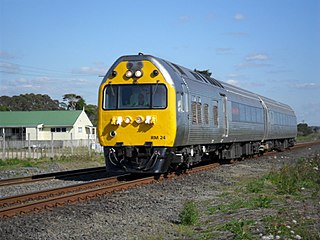
The NZR RM class Silver Fern was a class of rail motor in New Zealand. The three air-conditioned and sound-proofed 723-kW 96-seater diesel-electric twin-set railcars were built by Kawasaki under contract with Nissho Iwai of Japan. New Zealand Railways (NZR) classified the railcars as RM (Rail Motor), the same as other railcars, using the Silver Ferns (a national symbol of New Zealand) because of their exterior was made of corrugated stainless steel, like the premier night sleeper train that also ran on the Wellington-Auckland (North Island Main Trunk) route, the Silver Star. The Silver Ferns replaced the three successful Blue Streak railcars on the service.

The DQ and QR class were a class of diesel locomotives in New Zealand and Tasmania, Australia. Originally built by Clyde Engineering in the 1960s as Queensland Rail 1460 and 1502 class locomotives, they were purchased by Tranz Rail in 1995 to be rebuilt, as a cheaper alternative to buying new locomotives.
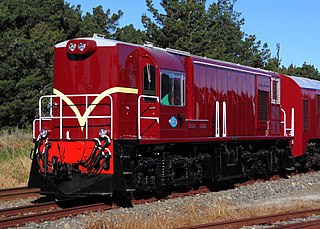
The New Zealand DI class locomotive was a class of diesel-electric locomotive in New Zealand. They were built by English Electric at their plant in Rocklea, Queensland in Australia. The class is very similar to the Queensland Railways 1620 class locomotives. At the time of their introduction, the class was seen as an alternative to the DB class for use on lightly laid secondary and branch lines, more so in the South Island. The World Bank financed introduction of the Japanese built DJ class in 1968, which ensured that no further DI class locomotives were purchased by New Zealand Railways.

The Mainline Steam Heritage Trust is a New Zealand charitable trust devoted to the restoration and operation of historic New Zealand Railways and overseas mainline steam locomotives. Regular day excursions and multi-day tours are operated over rail lines throughout New Zealand. Excursions are operated by the Auckland, Wellington and Christchurch branches.
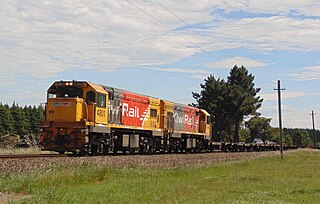
The New Zealand DC class locomotive is a type of diesel-electric mainline locomotive on the New Zealand rail network, operated by KiwiRail on freight trains, and formerly on long-distance passenger trains. The class was rebuilt from the DA class in the late 1970s and early 1980s, mainly in Australia. After the DA class, they were the most numerous class of diesel locomotive on New Zealand's railway network and remained numerically dominant until the mid-2010s when withdrawals began.
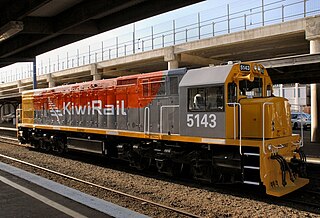
The New Zealand DX class locomotive is a type of 49 Co-Co diesel-electric locomotives that currently operate on New Zealand's national railway network. All locomotives are owned by KiwiRail.

The New Zealand DB class and DBR class locomotive is a type of diesel-electric locomotive built for service on New Zealand's rail network. They were built by General Motors Diesel (GMD) of Canada as a narrow-gauge version of the EMD G8 model, with seventeen locomotives constructed. Ten of these were later rebuilt into the DBR class.
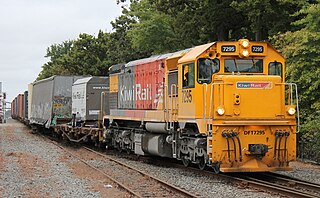
The New Zealand DF class locomotive of 1979 is a class of 30 Co-Co diesel-electric locomotives built by General Motors Diesel of Canada between 1979 and 1981. Between 1992 and 1997, all the locomotives were rebuilt as the DFT class, a turbocharged version of the DF.

The New Zealand DSC class locomotive is a heavy shunting locomotive used throughout New Zealand. The class was built in seven batches, the first 18 locomotives being built by British Thomson-Houston of the United Kingdom, with the remainder being built by New Zealand Railways (NZR).
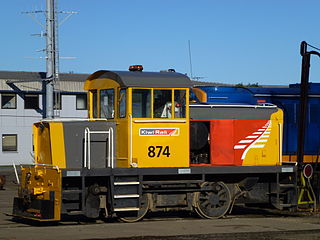
The New Zealand TR class locomotive is a type of diesel shunting locomotives built by many different manufacturers. Defined as "shunting tractors" or "rail tractors" by KiwiRail and its predecessors, they are classified "TR" for tractor as a result. Many of these locomotives have been withdrawn, but some are still in service. The first locomotive of this class was built by NZR in 1924. The most powerful were Japanese-built Hitachi TRs, with 138 kW Cummins engines.

Steam Incorporated, often abbreviated to Steam Inc., is a railway heritage and preservation society based at the Paekākāriki railway station, Paekākāriki at the southern end of the Kāpiti Coast, approximately 50 minutes north of Wellington on the west coast of New Zealand's North Island. Unlike some societies who operate on preserved sections of closed branch lines, Steam Incorporated owns a depot beside one of the country's most important railway lines, the North Island Main Trunk railway, and restores heritage locomotives and rolling stock for use on excursions on the regular national rail network.
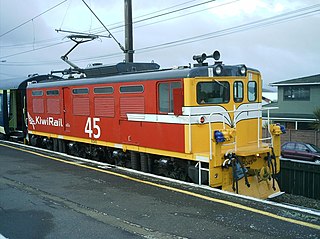
The New Zealand EA class of electric locomotives were used on the New Zealand rail network between 1968 and 1997 on the Otira – Arthur's Pass section of the Midland line in the South Island, through the Otira Tunnel. Following reconditioning, three were used by KiwiRail's Tranz Metro in Wellington from 2008 to 2011 to top and tail Metlink suburban passenger trains as an interim measure before new rolling stock arrived. Four of the five locomotives were scrapped in 2013 with one being set aside for preservation.

The New Zealand British Rail Mark 2 carriages were built by British Rail Engineering Limited for British Rail in the early 1970s. From the mid-1990s, 150 were exported to New Zealand. After being rebuilt, refurbished and re-gauged, they entered service with a variety of operators on New Zealand's railway network. The carriages generally replaced older NZR 56-foot carriages, some of which had been in use for almost 70 years.

The New Zealand AK class carriage is a type of 17 cars built by Dunedin's Hillside Workshops for KiwiRail's long-distance passenger operation The Great Journeys of New Zealand. Consisting of 11 AK saloon carriages and four AKC café carriages, supplemented by three AKL luggage vans and four AKV open-air viewing/generator vans converted from AG vans, similar to those previously used on the Coastal Pacific and the TranzAlpine. The AK class are the first new carriages to be built in New Zealand since 1943.
The NZR DSB class locomotive is a type of shunting locomotive introduced to New Zealand's national rail network in 1954 by New Zealand Railways (NZR).

Cato Blue is an informal term describing a New Zealand railway locomotive livery found in common usage amongst the railfan community. The livery was first worn on DFT 7160 as a variation of the New Zealand Rail blue livery. With the introduced of Tranz Rail on 18 October 1995, the livery was adopted to replace New Zealand Rails blue livery, which was introduced in 1991. The scheme was known as Cato Blue after its creator, Cato Partners. DFT 7199 was the first locomotive repainted in the livery after Tranz Rail took over the rail system.

Corn-Cob was an informal term, promoted by the editors of NZ Railfan magazine, describing a New Zealand railway locomotive livery found in common usage amongst the railfan community. The livery was introduced on 5 May 2004 when Toll Rail took over the rail system from Tranz Rail and replaced the Bumble-Bee livery. The livery was replaced by the KiwiRail Phase One livery in July 2008. DX 5379 was the first locomotive to wear the livery. The livery represents the colours of Toll Rail and the colours of Australia. When KiwiRail took over the rail system from Toll, the Toll logos on the locomotives were covered or "patched" with the KiwiRail logo.

The DQ class were a class of diesel locomotives in New Zealand and Tasmania. Originally built by Clyde Engineering in the 1960s as Queensland Rails 1460 and 1502 class locomotives. They were purchased by Tranz Rail in 1995 to be rebuilt, as a cheaper alternative to buying new locomotives. Tranz Rail rebuilt 16 locos into the DQ class. Tranz Rail then sold the 12 DQs to AN Tasrail. Only eight out of the twelve DQs are still in service today.
The QR class were a class of diesel locomotives in New Zealand and Tasmania. Originally built by Clyde Engineering between 1965 and 1966 as Queensland Rail's 1460 class locomotives. They were purchased by Tranz Rail in 1995 to be rebuilt, as a cheaper alternative to buying new locomotives. Seven were modified into the QR class. Three were leased to AN Tasrail for one year, but the locos were later sold in 2001. All three have since been scrapped.
The DC class was a class of diesel locomotives in New Zealand and Tasmania. Originally built by General Motors Canada and Clyde Engineering between 1955 and 1967 as New Zealand Government Railways DA class locomotive. Eighty-five DAs were rebuilt as the DC class locomotive. Tranz Rail, a successor of the NZGR, sold DC 4588 to AN Tasrail. It has since been scrapped.































